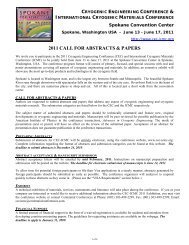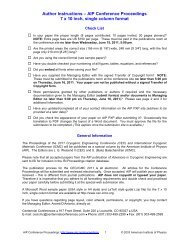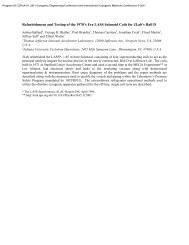CEC Abstracts in PDF format (as of 7/3/07) - CEC-ICMC 2013
CEC Abstracts in PDF format (as of 7/3/07) - CEC-ICMC 2013
CEC Abstracts in PDF format (as of 7/3/07) - CEC-ICMC 2013
You also want an ePaper? Increase the reach of your titles
YUMPU automatically turns print PDFs into web optimized ePapers that Google loves.
<strong>CEC</strong> 20<strong>07</strong> - <strong>Abstracts</strong><br />
C2-P-04 Cryogenic design <strong>of</strong> the ALUHEAT project<br />
I. Hiltunen, A. Korpela, R. Mikkonen, J. Lehtonen,<br />
Tampere University <strong>of</strong> Technology; M. Runde,<br />
SINTEF Energy Research; N. Magnusson, SINTEF<br />
Energy Research ; G. Kalkowski, Fraunh<strong>of</strong>er IOF.<br />
In this paper, the cryostat design <strong>of</strong> the ALUHEAT project that aims<br />
to build a cryogen-free superconduct<strong>in</strong>g <strong>in</strong>duction heater is presented<br />
<strong>in</strong> detail. Design<strong>in</strong>g <strong>of</strong> the cryostat <strong>in</strong>volves heat loss calculations,<br />
mechanical analysis and the optimization <strong>of</strong> current leads and cool<strong>in</strong>g<br />
conditions. The system consists <strong>of</strong> two separate cryostats between <strong>of</strong><br />
which the billet to be heated is located. Exceptionally short distance<br />
between the magnet and the cryostat wall, the large forces between the<br />
magnets <strong>in</strong> separate cryostats, and the rotation <strong>of</strong> the billet create<br />
application specific requirements that must be taken <strong>in</strong>to account.<br />
F<strong>in</strong>ite element analysis is used to design the cryostat to withstand both<br />
the vacuum and magnetic forces.<br />
F<strong>in</strong>ally, the thermal <strong>in</strong>terface, the radiation shield and the magnet<br />
support are designed and all components <strong>as</strong>sembled <strong>in</strong>to the complete<br />
system.<br />
C2-P-05 Introduction <strong>of</strong> the 35kV/90MVA Saturated Iron<br />
Core Type Superconduct<strong>in</strong>g Fault Current Limiter<br />
Y. X<strong>in</strong>, W.Z. Gong, X.Y. Niu, B. Tian, Z.J. Cao, H.X.<br />
Xi, Y. Yang, J.Y. Zhang, X,M. Hu, H. Hong, A.L. Ren,<br />
Z.L. Chen, H.H. Li, B. Hou, X.C. Yang, Innopower<br />
Superconductor Cable Co..<br />
A 35kV/90MVA prototype saturated iron core type superconduct<strong>in</strong>g<br />
fault current limiter w<strong>as</strong> developed and <strong>in</strong>stalled <strong>in</strong> a transmission<br />
network for test<strong>in</strong>g and trial operation. This prototype is <strong>of</strong> many<br />
unique features, such <strong>as</strong> actively de-magnetiz<strong>in</strong>g the iron core when a<br />
fault takes place to enhance the limit<strong>in</strong>g capacity, additional circuit for<br />
protect<strong>in</strong>g the dc current supply and other components <strong>in</strong> the dc bi<strong>as</strong><br />
side, and a new concept <strong>in</strong> iron core design. These <strong>in</strong>novations<br />
overcome the shortcom<strong>in</strong>gs that the long-established design <strong>of</strong> a<br />
saturated iron core type superconduct<strong>in</strong>g fault current limit<strong>in</strong>g device<br />
h<strong>as</strong>, mak<strong>in</strong>g this type <strong>of</strong> current limiter more reliable and efficient.<br />
For the 35kV/90MVA system, we plan to carry out a live-grid trial<br />
operation at Puji Substation <strong>of</strong> Ch<strong>in</strong>a Southern Power Grid for a long<br />
period <strong>of</strong> time. In this presentation, we will report the technical<br />
details <strong>of</strong> the system and the test<strong>in</strong>g results we have got up to date.<br />
C2-P-06 Modular concept for the cryopackag<strong>in</strong>g design.<br />
V.V. Borzenets, SLAC; I.V. Borzenets, Duke Univ.<br />
Cryocooled devices and <strong>as</strong>semblies always <strong>in</strong>volve two <strong>in</strong>terfaces: the<br />
cryogenic <strong>in</strong>terface which provides the required low temperatures, and<br />
the electronic <strong>in</strong>terface which essentially provides the function <strong>of</strong> your<br />
device. A problem with all current systems is that these two <strong>in</strong>terfaces<br />
are l<strong>in</strong>ked together. That means that <strong>in</strong> order to do any component<br />
replacement or electronics ma<strong>in</strong>tenance, the entire system h<strong>as</strong> to be<br />
shut down and taken apart. This <strong>in</strong>troduces extensive delays dur<strong>in</strong>g<br />
system <strong>as</strong>sembly and usage. More over, this rules out a system with<br />
e<strong>as</strong>ily <strong>in</strong>terchangeable electronic components.<br />
We propose a concept <strong>of</strong> modular packag<strong>in</strong>g that will completely<br />
decouple the cryogenic/temperature control <strong>in</strong>terface with the<br />
electronic <strong>in</strong>terface. This will result <strong>in</strong> the ability to quickly remove<br />
and replace one <strong>in</strong>terface without the need to shut down or<br />
dis<strong>as</strong>semble the other. This means that the system will not only have<br />
reduced servic<strong>in</strong>g time, but that the system will have the capability to<br />
do “cold swaps”. Conceptually, this would be achieved by hav<strong>in</strong>g a<br />
separate vacuum space for the cryogenic <strong>in</strong>terface <strong>as</strong> well <strong>as</strong> for each<br />
detachable electronic <strong>in</strong>terface block. The thermal contact for all low<br />
temperature stages <strong>of</strong> the cryocooler with the electronics package will<br />
be achieved via properly matched thermal metal to metal contacts.<br />
Wednesday, <strong>07</strong>/18/<strong>07</strong> Oral<br />
5:00pm - 6:00pm<br />
C2-R JT Coolers (Non-Aerospace)<br />
C2-R-01 F<strong>as</strong>t Cool-Down J-T Cryocooler to 88K<br />
N. Tzabar, I. Lifshits, A. Kaplansky, Rafael Ltd..<br />
F<strong>as</strong>t cool-down is usually implemented with J-T cryocoolers which<br />
also enable low-cost and small-scale systems. In this paper, we<br />
describe an analysis for achiev<strong>in</strong>g cool-down time <strong>of</strong> a few seconds to<br />
88K, us<strong>in</strong>g Argon <strong>as</strong> the ma<strong>in</strong> coolant, and at le<strong>as</strong>t 3 m<strong>in</strong>utes <strong>of</strong> steady<br />
state cool<strong>in</strong>g. It appears that accord<strong>in</strong>g to system demands, cost<br />
reduction, reliability, and manufactur<strong>in</strong>g considerations the use <strong>of</strong><br />
Argon <strong>as</strong> a s<strong>in</strong>gle coolant is more beneficial than precool<strong>in</strong>g with<br />
another coolant, such <strong>as</strong> Krypton. The results were successfully<br />
verified aga<strong>in</strong>st experimental data.<br />
C2-R-02 Vibration Characterization and Reduction <strong>of</strong> a<br />
Joule-Thomson Cryocooler for a SQUID-B<strong>as</strong>ed Metal<br />
Detection System<br />
G.J. De Groot, CSIRO Industrial Physics, M.A.<br />
SANTIN, CSIRO Industrial Physics & Federal<br />
University <strong>of</strong> Santa Catar<strong>in</strong>a, T. THIJSSEN, CSIRO<br />
Industrial Physics & University <strong>of</strong> Twente.<br />
Very sensitive high-temperature SQUID (Superconduct<strong>in</strong>g Quantum<br />
Interference Device) magnetometers are used for the detection <strong>of</strong> very<br />
small metal contam<strong>in</strong>ants <strong>in</strong> food and other products. When the<br />
SQUIDs are cooled with liquid nitrogen, a detection sensitivity <strong>of</strong> 500<br />
nAm2 <strong>in</strong> a 150 × 150 mm2 orifice is obta<strong>in</strong>ed [1]. However, when a<br />
commercial Joule-Thompson cryocooler w<strong>as</strong> used, the sensitivity w<strong>as</strong><br />
reduced by a factor <strong>of</strong> 5 due to spurious magnetic signals [2].<br />
In this study the emph<strong>as</strong>is is on understand<strong>in</strong>g noise that may be<br />
created due to mechanical vibrations <strong>in</strong> the cryocooler cold head. The<br />
natural frequencies <strong>of</strong> the cryocooler cold head are modelled and two<br />
mechanisms <strong>of</strong> noise generation are considered and analysed.<br />
Calculations show that the noise created by vibrat<strong>in</strong>g dipoles <strong>in</strong> the<br />
cold head may create noise <strong>of</strong> 1 pT up to 20 pT <strong>in</strong> the frequency range<br />
<strong>of</strong> 10 to 50 Hz. The vibration characteristics <strong>of</strong> several parts <strong>of</strong> the<br />
cryocooler cold head <strong>as</strong>sembly were determ<strong>in</strong>ed with a l<strong>as</strong>er<br />
vibrometer, a fluxgate magnetometer and through f<strong>in</strong>ite element<br />
simulations. Two natural frequencies <strong>of</strong> approximately 21 and 49 Hz<br />
are particularly noticeable and are also observed <strong>in</strong> the SQUID noise.<br />
Anti-vibration me<strong>as</strong>ures are <strong>in</strong>troduced to reduce external vibrations.<br />
Many thanks go out to Marcel Bick, David Tilbrook, Keith Leslie,<br />
Barry Mart<strong>in</strong>, Lawrence Dick<strong>in</strong>son, Prem Narang and Emma Mitchell<br />
for their support and <strong>in</strong>sights.<br />
C2-R-03 Performance <strong>of</strong> a precooled J-T refrigerator<br />
operat<strong>in</strong>g with refrigerant mixtures<br />
C.T. Sairam, G. Venkatarathnam, Indian Institute <strong>of</strong><br />
Technology Madr<strong>as</strong>.<br />
S<strong>in</strong>gle stage J-T refrigerators operat<strong>in</strong>g with refrigerant mixtures are<br />
under development worldwide. Precooled J-T refrigerators operat<strong>in</strong>g<br />
with refrigerant mixtures were studies by Alexeev et.al for operation<br />
<strong>in</strong> 90-100 K temperature range [1-2].<br />
In this paper we present the results obta<strong>in</strong>ed by us <strong>in</strong> a two stage J-T<br />
refrigerator. Mixtures <strong>of</strong> propane and ethane are used <strong>in</strong> the first stage,<br />
and mixtures <strong>of</strong> neon,nitrogen,methane, ethane and propane <strong>in</strong> the<br />
second stage. The refrigerator w<strong>as</strong> tested <strong>in</strong> the temperature range 69-<br />
85 K. A heat load <strong>of</strong> 9W w<strong>as</strong> met at a temperature <strong>of</strong> 77K with a<br />
power <strong>in</strong>put <strong>of</strong> 1.4 kW. A heat load <strong>of</strong> 50W w<strong>as</strong> met at a temperature<br />
<strong>of</strong> 100K with a power <strong>in</strong>put <strong>of</strong> 1.1-1.3 kW. The performance <strong>of</strong> the<br />
refrigerator with different mixtures <strong>in</strong> the precool<strong>in</strong>g stage and the<br />
ma<strong>in</strong> stage are described <strong>in</strong> this paper.<br />
References<br />
1.Alexeev, A., Ch. Haberstroh and H. Quack (1998) Further<br />
development <strong>of</strong> a mixed g<strong>as</strong> Joule-Thomson refrigerator. Advances <strong>in</strong><br />
Cryogenic Eng<strong>in</strong>eer<strong>in</strong>g, 43B, 1667-1675.<br />
2.Alexeev, A., Ch. Haberstroh and H. Quack (1999) Mixed G<strong>as</strong> J-T<br />
Cryocooler with Precool<strong>in</strong>g stage. Cryocoolers 10, 475-479.<br />
Page 33 <strong>of</strong> 53






